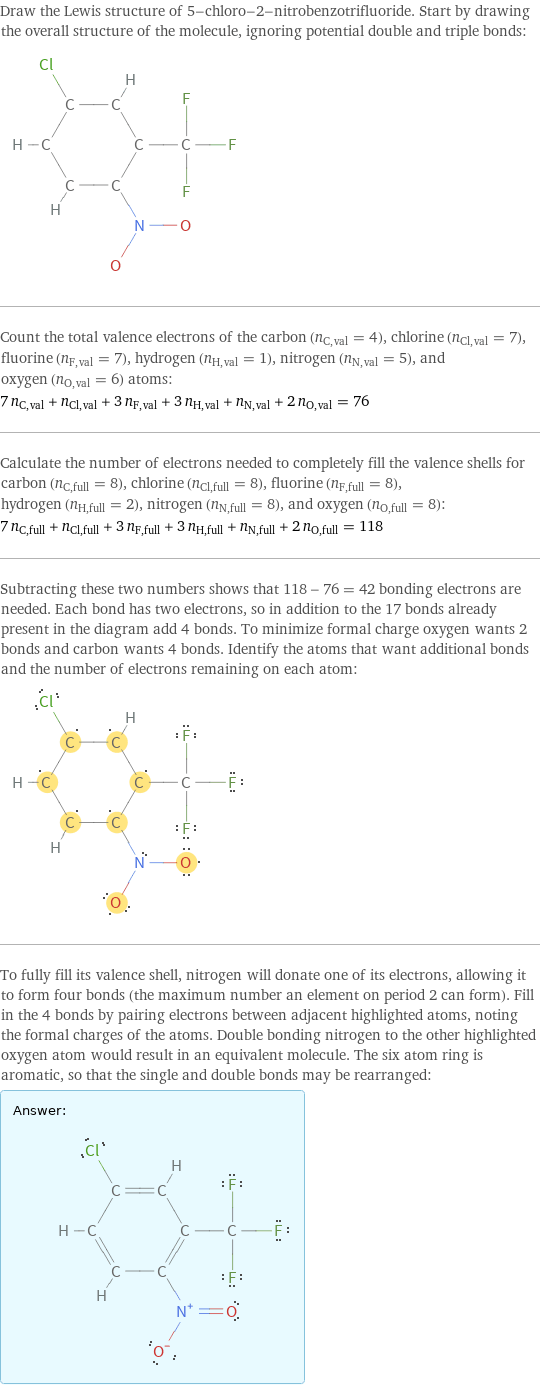Input interpretation

1 in^3 of 5-chloro-2-nitrobenzotrifluoride
Basic properties for 1 in^3

mass | 25 grams 0.025 kg (kilograms) 0.882 oz (ounces) molar amount | 111 mmol (millimoles) 0.111 mol (moles) volume | 16.4 mL (milliliters) 0.0164 L (liters) 16.4 cm^3 (cubic centimeters) 1.64×10^-5 m^3 (cubic meters) 0.554 fl oz (fluid ounces) 3.32 tsp (teaspoons) 1.11 tbsp (tablespoons) 0.0173 quarts equivalents | 0.111 eq (equivalents) (at STP)
Corresponding quantities

sphere radius | 1.576 cm (centimeters) side of a cube | 2.54 cm (centimeters)
Mass composition for 1 in^3

C (carbon) | 9.322 g (37.3%) Cl (chlorine) | 3.930 g (15.7%) F (fluorine) | 6.319 g (25.3%) H (hydrogen) | 0.335 g (1.3%) N (nitrogen) | 1.553 g (6.2%) O (oxygen) | 3.548 g (14.2%)

Mass composition for 1 in^3
Lewis structure

Draw the Lewis structure of 5-chloro-2-nitrobenzotrifluoride. Start by drawing the overall structure of the molecule, ignoring potential double and triple bonds: Count the total valence electrons of the carbon (n_C, val = 4), chlorine (n_Cl, val = 7), fluorine (n_F, val = 7), hydrogen (n_H, val = 1), nitrogen (n_N, val = 5), and oxygen (n_O, val = 6) atoms: 7 n_C, val + n_Cl, val + 3 n_F, val + 3 n_H, val + n_N, val + 2 n_O, val = 76 Calculate the number of electrons needed to completely fill the valence shells for carbon (n_C, full = 8), chlorine (n_Cl, full = 8), fluorine (n_F, full = 8), hydrogen (n_H, full = 2), nitrogen (n_N, full = 8), and oxygen (n_O, full = 8): 7 n_C, full + n_Cl, full + 3 n_F, full + 3 n_H, full + n_N, full + 2 n_O, full = 118 Subtracting these two numbers shows that 118 - 76 = 42 bonding electrons are needed. Each bond has two electrons, so in addition to the 17 bonds already present in the diagram add 4 bonds. To minimize formal charge oxygen wants 2 bonds and carbon wants 4 bonds. Identify the atoms that want additional bonds and the number of electrons remaining on each atom: To fully fill its valence shell, nitrogen will donate one of its electrons, allowing it to form four bonds (the maximum number an element on period 2 can form). Fill in the 4 bonds by pairing electrons between adjacent highlighted atoms, noting the formal charges of the atoms. Double bonding nitrogen to the other highlighted oxygen atom would result in an equivalent molecule. The six atom ring is aromatic, so that the single and double bonds may be rearranged: Answer: | |
Chemical names and formulas

formula | ClC_6H_3(NO_2)CF_3 Hill formula | C_7H_3ClF_3NO_2 name | 5-chloro-2-nitrobenzotrifluoride IUPAC name | 4-chloro-1-nitro-2-(trifluoromethyl)benzene
Substance properties

molar mass | 225.55 g/mol phase | liquid (at STP) melting point | 21 °C boiling point | 222 °C density | 1.526 g/cm^3
Units
